They assemble by beat of drum, each with his musket or firelock, in front of the captain’s door, they have their cloaks on, and place themselves in order, three abreast, and are led by a sergeant without beat of drum. Behind comes the Governor, in a long robe; beside him on the right hand, comes the preacher with his cloak on, and with a small cane in his hands; and so they march in good order, and each sets his arms down near him. Thus they are constantly on their guard night and day.
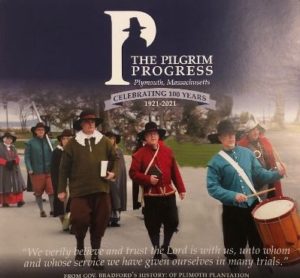
In this eyewitness account by Dutch secretary of the Colony of New Netherlands, Isaac DeRaisiers, written in 1627, he describes the Pilgrims “progressing” to church. George Boughton’s 1867 painting was later associated with Pilgrims. Today, a similar march depicting the Pilgrims going to church takes place the first four Fridays in August and also as part of the Town’s celebration of Thanksgiving Day. Each marcher represents one of the 51 survivors of the first harsh winter of 1620-21. Thus, we faithfully re-live the Sabbath procession of the Pilgrims going to worship!
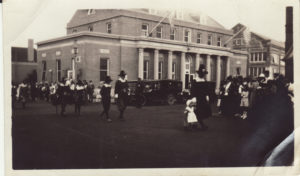 The first Pilgrim Progress took place on July 21, 1921 as part of the Tercentenary celebration which was to “honor the faith and courage of our Pilgrim Forefathers.” That first “Progress” was inspired by Mrs. Richard Morgan, a Plymouth woman of Pilgrim descent, when she read Webster’s 1820 oration honoring Forefathers Day (the day the Pilgrims stepped on Plymouth Rock) at its two hundredth anniversary. She came up with the idea of a Pilgrim Progress, took it to the Selectmen, received their approval and a “modest appropriation;” and thus, the Pilgrim Progress was born!
The first Pilgrim Progress took place on July 21, 1921 as part of the Tercentenary celebration which was to “honor the faith and courage of our Pilgrim Forefathers.” That first “Progress” was inspired by Mrs. Richard Morgan, a Plymouth woman of Pilgrim descent, when she read Webster’s 1820 oration honoring Forefathers Day (the day the Pilgrims stepped on Plymouth Rock) at its two hundredth anniversary. She came up with the idea of a Pilgrim Progress, took it to the Selectmen, received their approval and a “modest appropriation;” and thus, the Pilgrim Progress was born!
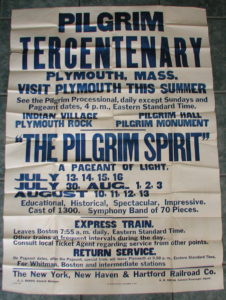
OLYMPUS DIGITAL CAMERA
The first Pilgrim Progress took place on July 21, 1921 as part of the Tercentenary celebration which was to “honor the faith and courage of our Pilgrim Forefathers.” That first “Progress” was inspired by Mrs. Richard Morgan, a Plymouth woman of Pilgrim descent, when she read Webster’s 1820 oration honoring Forefathers Day (the day the Pilgrims stepped on Plymouth Rock) at its two hundredth anniversary. She came up with the idea of a Pilgrim Progress, took it to the Selectmen, received their approval and a “modest appropriation;” and thus, the Pilgrim Progress was born!
The first Progress was a part of “The Pilgrim Spirit”, the pageant in 1920-21. Most residents in the town participated in this pageant. The Railroad Poster advertising it states; “the procession will be repeated daily throughout the summer in connection with the observation of the tercentenary celebration.” As Plymouth historian Jim Baker wrote, “The Progress took place on the last day of the Tercentenary (September 5, 1921), following the dedication of the Massasoit statue and going up Leyden Street to School Street at 5:30, and up to the top of Burial Hill and along to the site of the Fort for a brief sunset service at 6 (before everyone returned to Cole’s Hill for a band concert and fireworks.)
The original trio who began to form the Progress into a traditional procession each summer following the Tercentenary was made up of Rose Thornton Briggs, Mrs. Arthur Lord, and Helen F. Finney, secretary to the Tercentenary Committee. Rose Briggs, considered the “mother” of the Pilgrim Progress, continued to make costumes for 33 years. She continued the tradition except for several years during World War II. Costumes were kept at First Baptist Church (eventually sold to the Salvation Army) and the processions were organized from there. Costumes were stored in the Winslow House (now Mayflower Society House) during World War II and were stored in Kendall Hall as well, but for the past few decades at the Mayflower Society House on North Street.
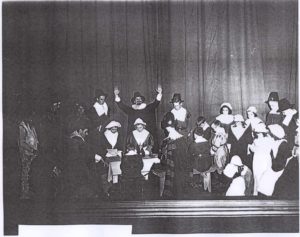
Baker writes “In the 1950’s Rose Briggs, who had designed and made the original costumes, and Mrs. Dittmar worked with the Antiquarians to recruit the 52 volunteers for each event, then dressed them before sending them straggling down to the waterfront where they re-assembled and marched back up Leyden Street to the top of Burial Hill (via the main stairway). Each individual was assigned a name, not that we did anything with them in the procession. Adrian Whiting was the perennial Myles Standish.” Baker remembers that both the Pilgrim Progress and the associated tableaux “A Pilgrim Chronicle” were begun and maintained by the Antiquarian Society until 1960.

I’ve been involved with Pilgrim Progress since 1983 when my youngest, Susan, was a year old. I remember getting ready for the Progress on Friday afternoons and having each of my four children see if any of their friends could be pilgrims that afternoon. We would all pile into the car and head up town! Today the sponsors of the Progress include Plymouth Rock Foundation, General Society of Mayflower Descendants, and the Town of Plymouth Promotions Fund. The marchers represent the Pilgrim settlers – men, women and children – who survived the first desperate winter at Plymouth and lived to found the colony which has proved a cornerstone of the nation.
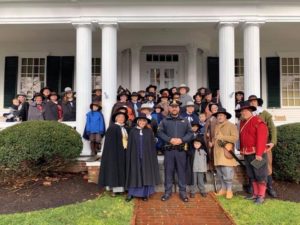
“As one small candle may light a thousand” writes William Bradford, “so the light here kindled has shown to many, yea, in some sort to our whole nation.” The solemn procession and simple ceremony highlighting the psalms, a short sermon and benediction, true to a Pilgrim church service, keeps alive the fact that it was truly their faith which brought them here and caused them to continue, “whatsoever it should cost them.”
It is an honor to keep such a tradition alive so that future generations will know the true motive for the Pilgrim arrival. We must remember this today!







